Evaluation of Tesco's Business Strategy and Performance
VerifiedAdded on 2023/01/11
|13
|3974
|76
Report
AI Summary
This report provides a detailed analysis of Tesco's business strategy. It begins with an introduction outlining the purpose and scope of the report, followed by an examination of Tesco's mission, vision, objectives, and their value. The main body of the report then analyzes Tesco's competitive advantage using the VRIO framework, assessing its resources and capabilities. A PESTLE analysis is conducted to evaluate the external environment, considering political, economic, social, technological, legal, and environmental factors. Porter's Five Forces model is employed to assess the competitiveness of Tesco within the UK retail industry. Finally, the report reviews Tesco's overall business strategy, drawing conclusions based on the analyses. The report highlights Tesco's strengths, weaknesses, opportunities, and threats, providing a comprehensive understanding of its strategic position and future prospects.

Strategy Evaluation
Paraphrase This Document
Need a fresh take? Get an instant paraphrase of this document with our AI Paraphraser
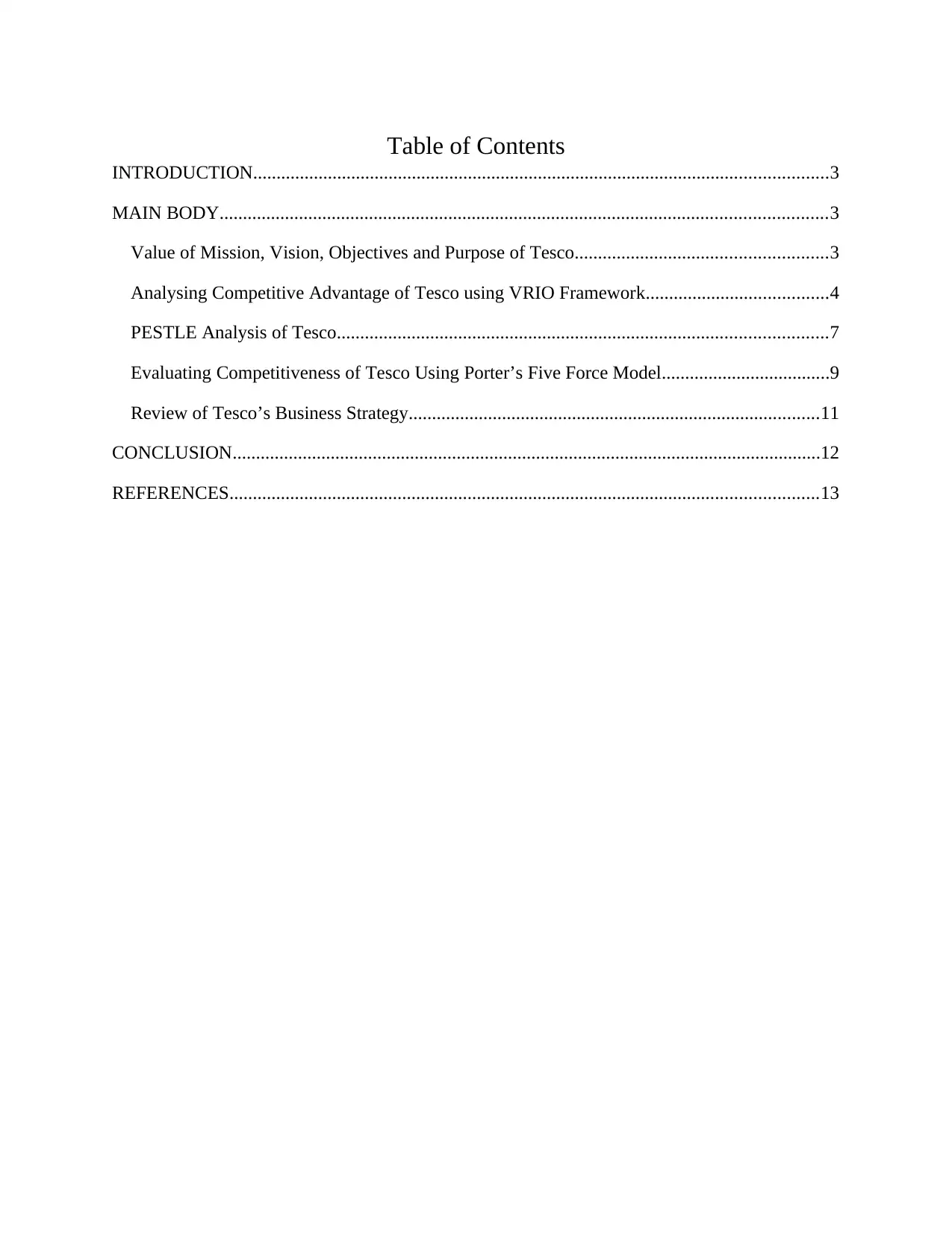
Table of Contents
INTRODUCTION...........................................................................................................................3
MAIN BODY..................................................................................................................................3
Value of Mission, Vision, Objectives and Purpose of Tesco......................................................3
Analysing Competitive Advantage of Tesco using VRIO Framework.......................................4
PESTLE Analysis of Tesco.........................................................................................................7
Evaluating Competitiveness of Tesco Using Porter’s Five Force Model....................................9
Review of Tesco’s Business Strategy........................................................................................11
CONCLUSION..............................................................................................................................12
REFERENCES..............................................................................................................................13
INTRODUCTION...........................................................................................................................3
MAIN BODY..................................................................................................................................3
Value of Mission, Vision, Objectives and Purpose of Tesco......................................................3
Analysing Competitive Advantage of Tesco using VRIO Framework.......................................4
PESTLE Analysis of Tesco.........................................................................................................7
Evaluating Competitiveness of Tesco Using Porter’s Five Force Model....................................9
Review of Tesco’s Business Strategy........................................................................................11
CONCLUSION..............................................................................................................................12
REFERENCES..............................................................................................................................13
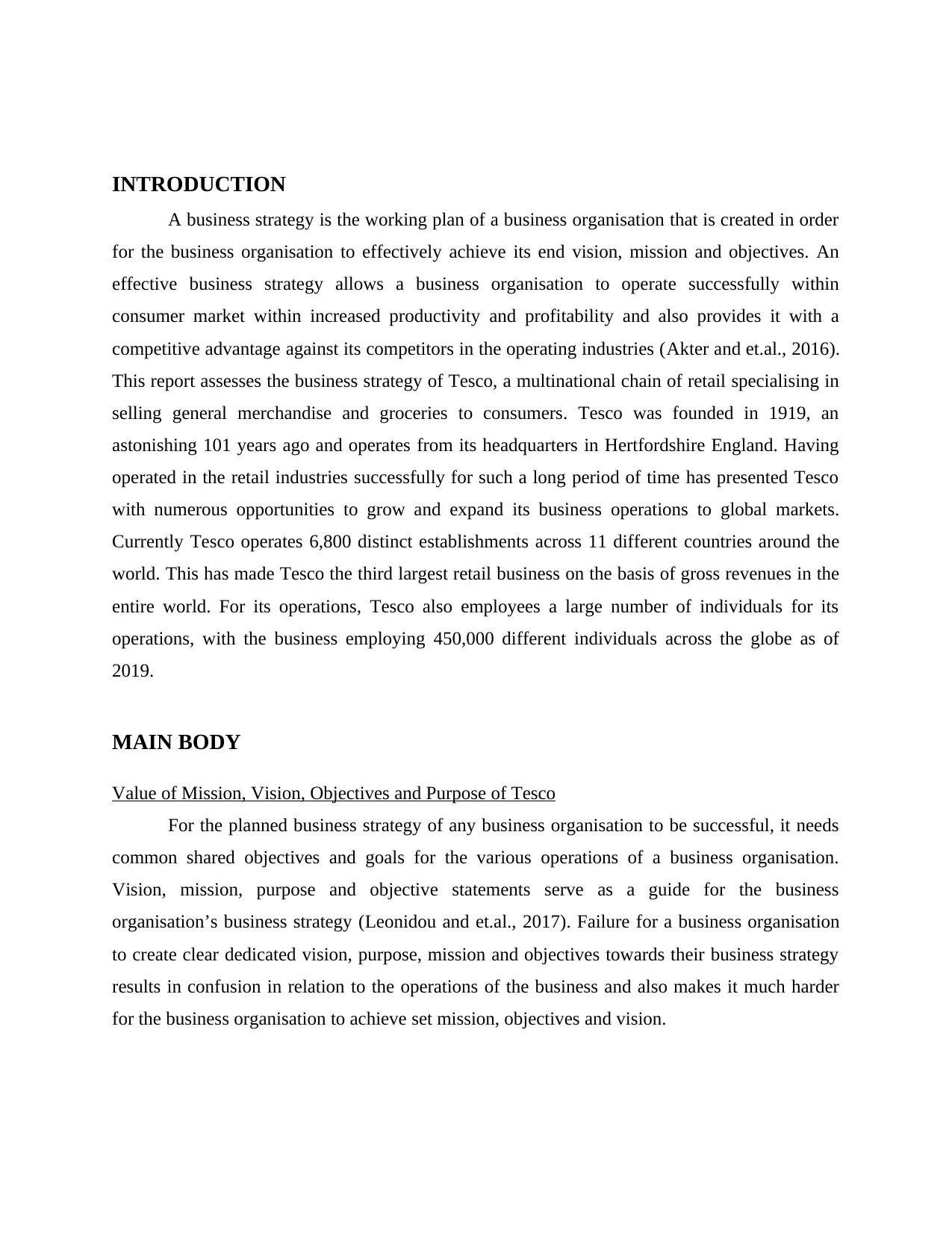
INTRODUCTION
A business strategy is the working plan of a business organisation that is created in order
for the business organisation to effectively achieve its end vision, mission and objectives. An
effective business strategy allows a business organisation to operate successfully within
consumer market within increased productivity and profitability and also provides it with a
competitive advantage against its competitors in the operating industries (Akter and et.al., 2016).
This report assesses the business strategy of Tesco, a multinational chain of retail specialising in
selling general merchandise and groceries to consumers. Tesco was founded in 1919, an
astonishing 101 years ago and operates from its headquarters in Hertfordshire England. Having
operated in the retail industries successfully for such a long period of time has presented Tesco
with numerous opportunities to grow and expand its business operations to global markets.
Currently Tesco operates 6,800 distinct establishments across 11 different countries around the
world. This has made Tesco the third largest retail business on the basis of gross revenues in the
entire world. For its operations, Tesco also employees a large number of individuals for its
operations, with the business employing 450,000 different individuals across the globe as of
2019.
MAIN BODY
Value of Mission, Vision, Objectives and Purpose of Tesco
For the planned business strategy of any business organisation to be successful, it needs
common shared objectives and goals for the various operations of a business organisation.
Vision, mission, purpose and objective statements serve as a guide for the business
organisation’s business strategy (Leonidou and et.al., 2017). Failure for a business organisation
to create clear dedicated vision, purpose, mission and objectives towards their business strategy
results in confusion in relation to the operations of the business and also makes it much harder
for the business organisation to achieve set mission, objectives and vision.
A business strategy is the working plan of a business organisation that is created in order
for the business organisation to effectively achieve its end vision, mission and objectives. An
effective business strategy allows a business organisation to operate successfully within
consumer market within increased productivity and profitability and also provides it with a
competitive advantage against its competitors in the operating industries (Akter and et.al., 2016).
This report assesses the business strategy of Tesco, a multinational chain of retail specialising in
selling general merchandise and groceries to consumers. Tesco was founded in 1919, an
astonishing 101 years ago and operates from its headquarters in Hertfordshire England. Having
operated in the retail industries successfully for such a long period of time has presented Tesco
with numerous opportunities to grow and expand its business operations to global markets.
Currently Tesco operates 6,800 distinct establishments across 11 different countries around the
world. This has made Tesco the third largest retail business on the basis of gross revenues in the
entire world. For its operations, Tesco also employees a large number of individuals for its
operations, with the business employing 450,000 different individuals across the globe as of
2019.
MAIN BODY
Value of Mission, Vision, Objectives and Purpose of Tesco
For the planned business strategy of any business organisation to be successful, it needs
common shared objectives and goals for the various operations of a business organisation.
Vision, mission, purpose and objective statements serve as a guide for the business
organisation’s business strategy (Leonidou and et.al., 2017). Failure for a business organisation
to create clear dedicated vision, purpose, mission and objectives towards their business strategy
results in confusion in relation to the operations of the business and also makes it much harder
for the business organisation to achieve set mission, objectives and vision.
⊘ This is a preview!⊘
Do you want full access?
Subscribe today to unlock all pages.

Trusted by 1+ million students worldwide
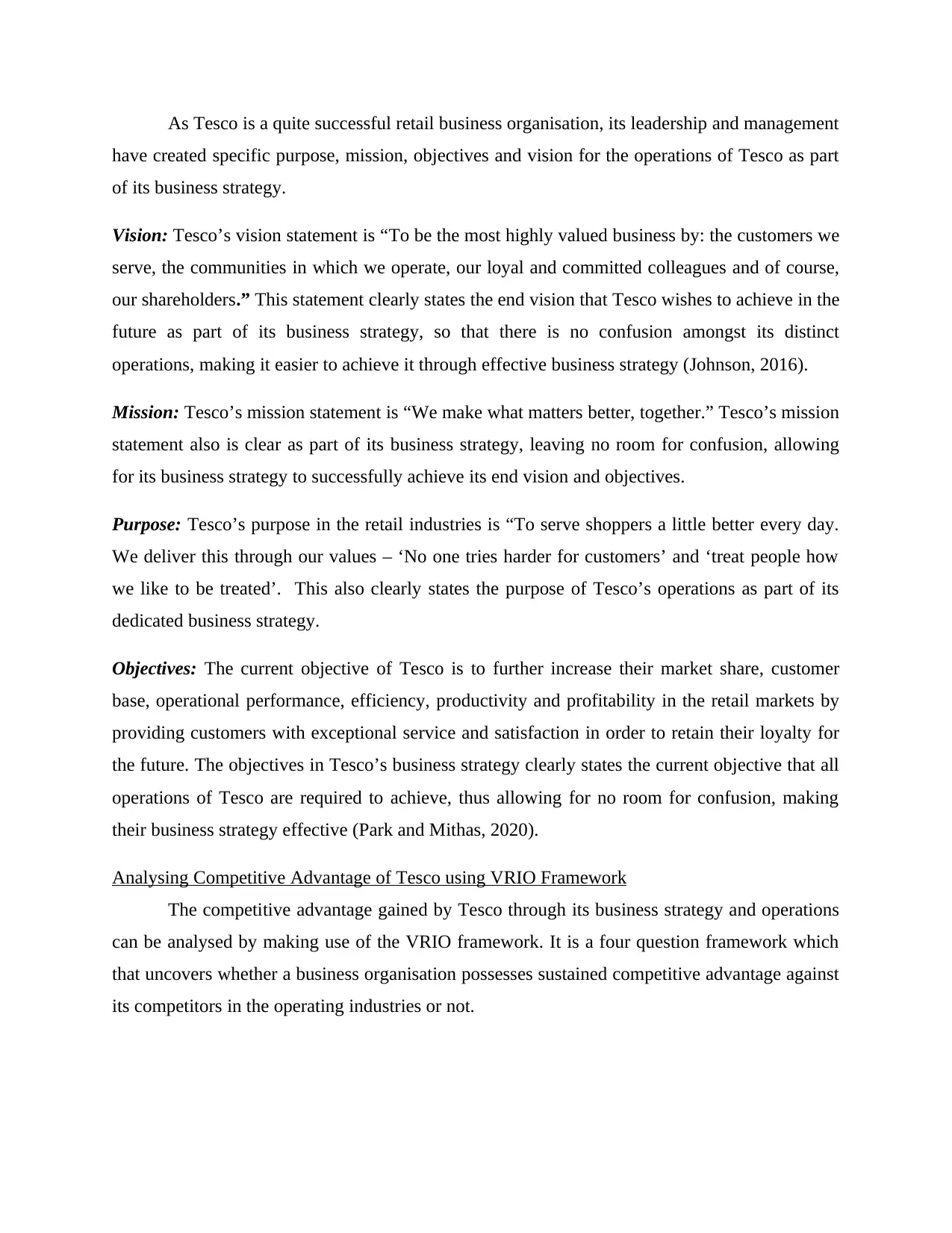
As Tesco is a quite successful retail business organisation, its leadership and management
have created specific purpose, mission, objectives and vision for the operations of Tesco as part
of its business strategy.
Vision: Tesco’s vision statement is “To be the most highly valued business by: the customers we
serve, the communities in which we operate, our loyal and committed colleagues and of course,
our shareholders.” This statement clearly states the end vision that Tesco wishes to achieve in the
future as part of its business strategy, so that there is no confusion amongst its distinct
operations, making it easier to achieve it through effective business strategy (Johnson, 2016).
Mission: Tesco’s mission statement is “We make what matters better, together.” Tesco’s mission
statement also is clear as part of its business strategy, leaving no room for confusion, allowing
for its business strategy to successfully achieve its end vision and objectives.
Purpose: Tesco’s purpose in the retail industries is “To serve shoppers a little better every day.
We deliver this through our values – ‘No one tries harder for customers’ and ‘treat people how
we like to be treated’. This also clearly states the purpose of Tesco’s operations as part of its
dedicated business strategy.
Objectives: The current objective of Tesco is to further increase their market share, customer
base, operational performance, efficiency, productivity and profitability in the retail markets by
providing customers with exceptional service and satisfaction in order to retain their loyalty for
the future. The objectives in Tesco’s business strategy clearly states the current objective that all
operations of Tesco are required to achieve, thus allowing for no room for confusion, making
their business strategy effective (Park and Mithas, 2020).
Analysing Competitive Advantage of Tesco using VRIO Framework
The competitive advantage gained by Tesco through its business strategy and operations
can be analysed by making use of the VRIO framework. It is a four question framework which
that uncovers whether a business organisation possesses sustained competitive advantage against
its competitors in the operating industries or not.
have created specific purpose, mission, objectives and vision for the operations of Tesco as part
of its business strategy.
Vision: Tesco’s vision statement is “To be the most highly valued business by: the customers we
serve, the communities in which we operate, our loyal and committed colleagues and of course,
our shareholders.” This statement clearly states the end vision that Tesco wishes to achieve in the
future as part of its business strategy, so that there is no confusion amongst its distinct
operations, making it easier to achieve it through effective business strategy (Johnson, 2016).
Mission: Tesco’s mission statement is “We make what matters better, together.” Tesco’s mission
statement also is clear as part of its business strategy, leaving no room for confusion, allowing
for its business strategy to successfully achieve its end vision and objectives.
Purpose: Tesco’s purpose in the retail industries is “To serve shoppers a little better every day.
We deliver this through our values – ‘No one tries harder for customers’ and ‘treat people how
we like to be treated’. This also clearly states the purpose of Tesco’s operations as part of its
dedicated business strategy.
Objectives: The current objective of Tesco is to further increase their market share, customer
base, operational performance, efficiency, productivity and profitability in the retail markets by
providing customers with exceptional service and satisfaction in order to retain their loyalty for
the future. The objectives in Tesco’s business strategy clearly states the current objective that all
operations of Tesco are required to achieve, thus allowing for no room for confusion, making
their business strategy effective (Park and Mithas, 2020).
Analysing Competitive Advantage of Tesco using VRIO Framework
The competitive advantage gained by Tesco through its business strategy and operations
can be analysed by making use of the VRIO framework. It is a four question framework which
that uncovers whether a business organisation possesses sustained competitive advantage against
its competitors in the operating industries or not.
Paraphrase This Document
Need a fresh take? Get an instant paraphrase of this document with our AI Paraphraser
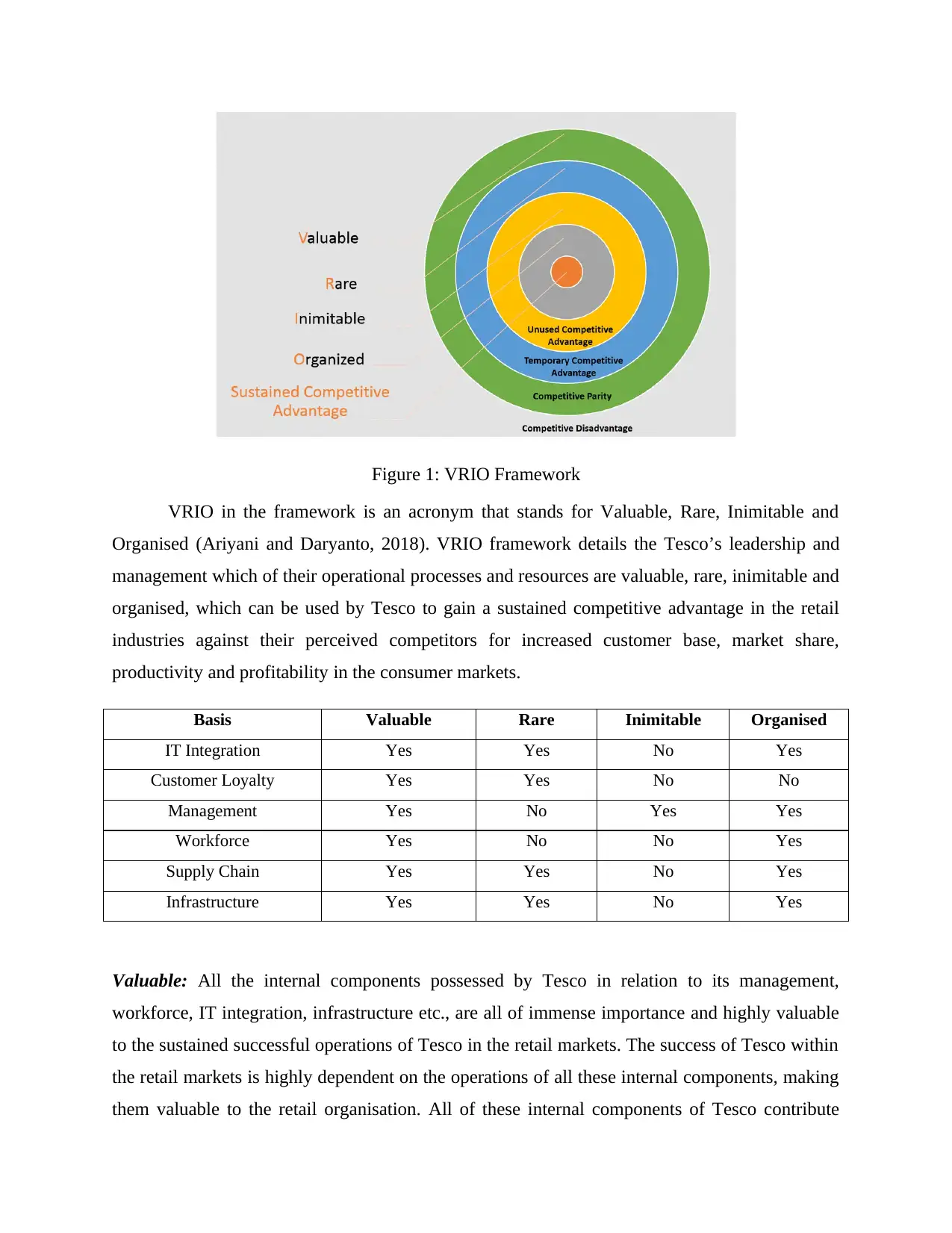
Figure 1: VRIO Framework
VRIO in the framework is an acronym that stands for Valuable, Rare, Inimitable and
Organised (Ariyani and Daryanto, 2018). VRIO framework details the Tesco’s leadership and
management which of their operational processes and resources are valuable, rare, inimitable and
organised, which can be used by Tesco to gain a sustained competitive advantage in the retail
industries against their perceived competitors for increased customer base, market share,
productivity and profitability in the consumer markets.
Basis Valuable Rare Inimitable Organised
IT Integration Yes Yes No Yes
Customer Loyalty Yes Yes No No
Management Yes No Yes Yes
Workforce Yes No No Yes
Supply Chain Yes Yes No Yes
Infrastructure Yes Yes No Yes
Valuable: All the internal components possessed by Tesco in relation to its management,
workforce, IT integration, infrastructure etc., are all of immense importance and highly valuable
to the sustained successful operations of Tesco in the retail markets. The success of Tesco within
the retail markets is highly dependent on the operations of all these internal components, making
them valuable to the retail organisation. All of these internal components of Tesco contribute
VRIO in the framework is an acronym that stands for Valuable, Rare, Inimitable and
Organised (Ariyani and Daryanto, 2018). VRIO framework details the Tesco’s leadership and
management which of their operational processes and resources are valuable, rare, inimitable and
organised, which can be used by Tesco to gain a sustained competitive advantage in the retail
industries against their perceived competitors for increased customer base, market share,
productivity and profitability in the consumer markets.
Basis Valuable Rare Inimitable Organised
IT Integration Yes Yes No Yes
Customer Loyalty Yes Yes No No
Management Yes No Yes Yes
Workforce Yes No No Yes
Supply Chain Yes Yes No Yes
Infrastructure Yes Yes No Yes
Valuable: All the internal components possessed by Tesco in relation to its management,
workforce, IT integration, infrastructure etc., are all of immense importance and highly valuable
to the sustained successful operations of Tesco in the retail markets. The success of Tesco within
the retail markets is highly dependent on the operations of all these internal components, making
them valuable to the retail organisation. All of these internal components of Tesco contribute

significantly to the current success of Tesco in the retail industries and can also help Tesco in the
future gain competitive advantage against their competitors in the retail industries through
contributions of their individual operations.
Rare: The level of IT integration to the various processes of Tesco, the customer loyalty it
possesses, its supply chain operations and its developed infrastructure are all rare resources
within the retail industries and contribute significantly towards providing it with a sustained
competitive advantage against its competitors within the retail industries. Tesco’s large
investments into its infrastructure and IT integration make these internal components rare against
its competitors (Nam and Yi, 2020). The level of customer loyalty possessed by Tesco is also
highly rare within the retail industries, while its great long term relations with suppliers also add
to its rare components, all of which contribute significantly to provide Tesco with a sustained
competitive advantage against its competitors.
Inimitable: Only the effective management operations of Tesco cannot be imitated by their
perceived competitors within the retail industries, as though many of the internal components of
Tesco are valuable and rare, most of them can be imitated by their competitors within the retail
markets, given enough time. Though the IT integration, infrastructure and supply chain of Tesco
is rare, investment by their competitors into their own operations can yield resources similar to
those that Tesco possesses. If Tesco’s competitors start to place greater emphasis on customer
satisfaction and loyalty, they too would be able to possess the rare customer loyalty metrics that
Tesco currently possesses (Vargas-Hernandez and Medrano, 2020). To improve this and gain a
sustained competitive advantage, Tesco can invest into its research and development of new IT
software and systems which cannot be imitated by their competitors.
Organised: All internal components of Tesco are strategically organised, except for customer
loyalty, providing Tesco’s diverse operations with a lot of fluency to work together cohesively in
order to achieve the goals and objective of Tesco’s business strategy. This contributes
significantly towards providing Tesco with sustained competitive advantage within the retail
industries.
future gain competitive advantage against their competitors in the retail industries through
contributions of their individual operations.
Rare: The level of IT integration to the various processes of Tesco, the customer loyalty it
possesses, its supply chain operations and its developed infrastructure are all rare resources
within the retail industries and contribute significantly towards providing it with a sustained
competitive advantage against its competitors within the retail industries. Tesco’s large
investments into its infrastructure and IT integration make these internal components rare against
its competitors (Nam and Yi, 2020). The level of customer loyalty possessed by Tesco is also
highly rare within the retail industries, while its great long term relations with suppliers also add
to its rare components, all of which contribute significantly to provide Tesco with a sustained
competitive advantage against its competitors.
Inimitable: Only the effective management operations of Tesco cannot be imitated by their
perceived competitors within the retail industries, as though many of the internal components of
Tesco are valuable and rare, most of them can be imitated by their competitors within the retail
markets, given enough time. Though the IT integration, infrastructure and supply chain of Tesco
is rare, investment by their competitors into their own operations can yield resources similar to
those that Tesco possesses. If Tesco’s competitors start to place greater emphasis on customer
satisfaction and loyalty, they too would be able to possess the rare customer loyalty metrics that
Tesco currently possesses (Vargas-Hernandez and Medrano, 2020). To improve this and gain a
sustained competitive advantage, Tesco can invest into its research and development of new IT
software and systems which cannot be imitated by their competitors.
Organised: All internal components of Tesco are strategically organised, except for customer
loyalty, providing Tesco’s diverse operations with a lot of fluency to work together cohesively in
order to achieve the goals and objective of Tesco’s business strategy. This contributes
significantly towards providing Tesco with sustained competitive advantage within the retail
industries.
⊘ This is a preview!⊘
Do you want full access?
Subscribe today to unlock all pages.

Trusted by 1+ million students worldwide

PESTLE Analysis of Tesco
In order to assess the external environment in which Tesco operates in and the various
factors present in the external environment of Tesco, which can influence and impact the
operations, productivity and profitability of Tesco in the retail markets of UK, we make use of
the PESTLE analysis. This analysis details all the political, economic, social, technological, legal
and environmental factors present in the external environment which can have an impact on
Tesco’s operations, productivity and profitability within UK’s retail markets (Perera, 2017). The
PESTLE analysis for Tesco is as follows:
Figure 2: PESTLE Analysis
Political Factors: Although there are several political factors that can have an impact on the
operations of Tesco in UK, the most significant political factor relates to the current political
instability in UK owing to Brexit. Though the exact details of changes post Brexit still haven’t
been made available to the public and are highly debated on by economists and analysts, Brexit
can have a positive impact on the productivity and profitability of Tesco in retail markets of UK.
As Brexit will inevitably result in the scrapping of current complex international trading laws
and policies towards more transparent ones, this can have a significantly positive impact on the
international trading operations of Tesco, enhancing its profitability.
In order to assess the external environment in which Tesco operates in and the various
factors present in the external environment of Tesco, which can influence and impact the
operations, productivity and profitability of Tesco in the retail markets of UK, we make use of
the PESTLE analysis. This analysis details all the political, economic, social, technological, legal
and environmental factors present in the external environment which can have an impact on
Tesco’s operations, productivity and profitability within UK’s retail markets (Perera, 2017). The
PESTLE analysis for Tesco is as follows:
Figure 2: PESTLE Analysis
Political Factors: Although there are several political factors that can have an impact on the
operations of Tesco in UK, the most significant political factor relates to the current political
instability in UK owing to Brexit. Though the exact details of changes post Brexit still haven’t
been made available to the public and are highly debated on by economists and analysts, Brexit
can have a positive impact on the productivity and profitability of Tesco in retail markets of UK.
As Brexit will inevitably result in the scrapping of current complex international trading laws
and policies towards more transparent ones, this can have a significantly positive impact on the
international trading operations of Tesco, enhancing its profitability.
Paraphrase This Document
Need a fresh take? Get an instant paraphrase of this document with our AI Paraphraser
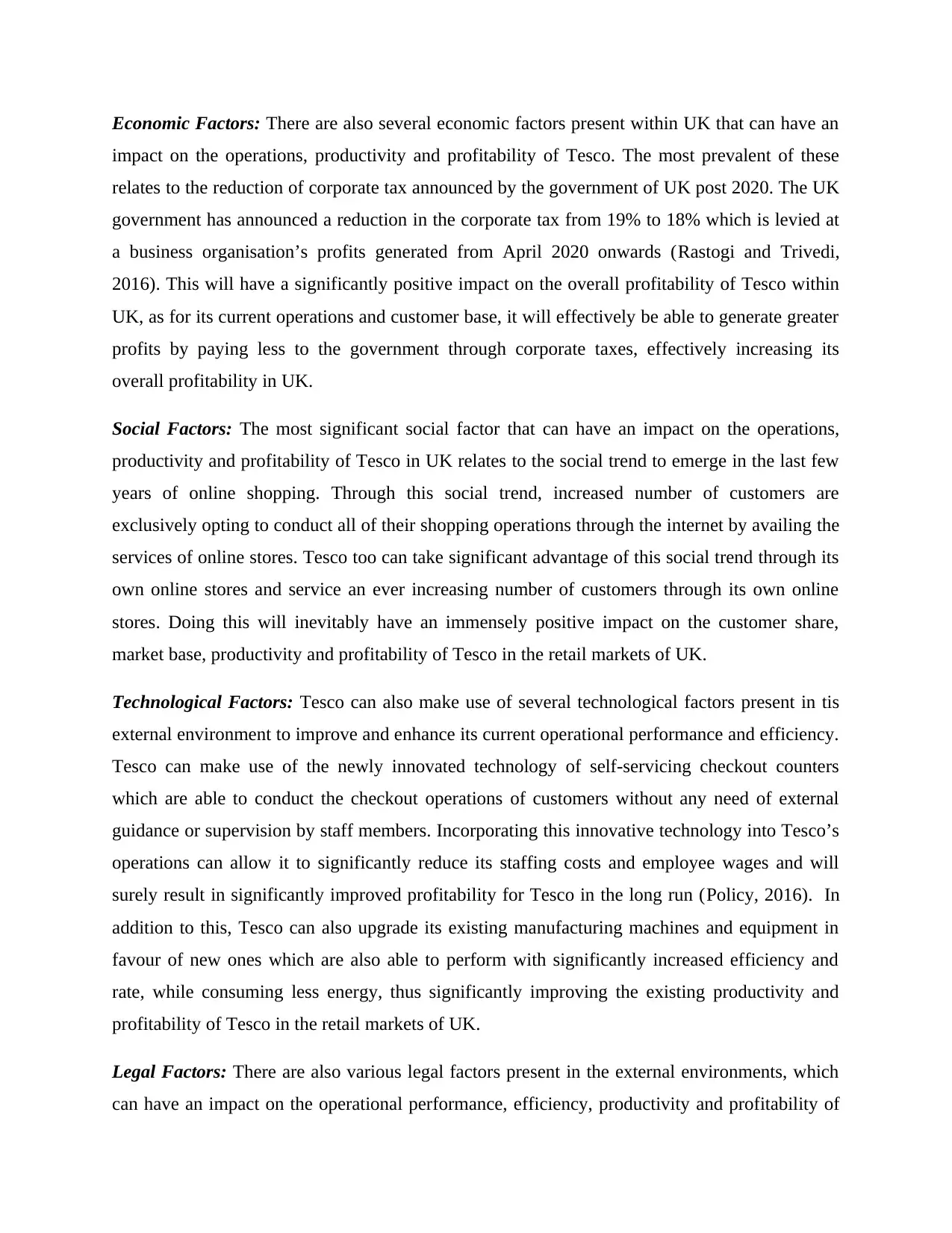
Economic Factors: There are also several economic factors present within UK that can have an
impact on the operations, productivity and profitability of Tesco. The most prevalent of these
relates to the reduction of corporate tax announced by the government of UK post 2020. The UK
government has announced a reduction in the corporate tax from 19% to 18% which is levied at
a business organisation’s profits generated from April 2020 onwards (Rastogi and Trivedi,
2016). This will have a significantly positive impact on the overall profitability of Tesco within
UK, as for its current operations and customer base, it will effectively be able to generate greater
profits by paying less to the government through corporate taxes, effectively increasing its
overall profitability in UK.
Social Factors: The most significant social factor that can have an impact on the operations,
productivity and profitability of Tesco in UK relates to the social trend to emerge in the last few
years of online shopping. Through this social trend, increased number of customers are
exclusively opting to conduct all of their shopping operations through the internet by availing the
services of online stores. Tesco too can take significant advantage of this social trend through its
own online stores and service an ever increasing number of customers through its own online
stores. Doing this will inevitably have an immensely positive impact on the customer share,
market base, productivity and profitability of Tesco in the retail markets of UK.
Technological Factors: Tesco can also make use of several technological factors present in tis
external environment to improve and enhance its current operational performance and efficiency.
Tesco can make use of the newly innovated technology of self-servicing checkout counters
which are able to conduct the checkout operations of customers without any need of external
guidance or supervision by staff members. Incorporating this innovative technology into Tesco’s
operations can allow it to significantly reduce its staffing costs and employee wages and will
surely result in significantly improved profitability for Tesco in the long run (Policy, 2016). In
addition to this, Tesco can also upgrade its existing manufacturing machines and equipment in
favour of new ones which are also able to perform with significantly increased efficiency and
rate, while consuming less energy, thus significantly improving the existing productivity and
profitability of Tesco in the retail markets of UK.
Legal Factors: There are also various legal factors present in the external environments, which
can have an impact on the operational performance, efficiency, productivity and profitability of
impact on the operations, productivity and profitability of Tesco. The most prevalent of these
relates to the reduction of corporate tax announced by the government of UK post 2020. The UK
government has announced a reduction in the corporate tax from 19% to 18% which is levied at
a business organisation’s profits generated from April 2020 onwards (Rastogi and Trivedi,
2016). This will have a significantly positive impact on the overall profitability of Tesco within
UK, as for its current operations and customer base, it will effectively be able to generate greater
profits by paying less to the government through corporate taxes, effectively increasing its
overall profitability in UK.
Social Factors: The most significant social factor that can have an impact on the operations,
productivity and profitability of Tesco in UK relates to the social trend to emerge in the last few
years of online shopping. Through this social trend, increased number of customers are
exclusively opting to conduct all of their shopping operations through the internet by availing the
services of online stores. Tesco too can take significant advantage of this social trend through its
own online stores and service an ever increasing number of customers through its own online
stores. Doing this will inevitably have an immensely positive impact on the customer share,
market base, productivity and profitability of Tesco in the retail markets of UK.
Technological Factors: Tesco can also make use of several technological factors present in tis
external environment to improve and enhance its current operational performance and efficiency.
Tesco can make use of the newly innovated technology of self-servicing checkout counters
which are able to conduct the checkout operations of customers without any need of external
guidance or supervision by staff members. Incorporating this innovative technology into Tesco’s
operations can allow it to significantly reduce its staffing costs and employee wages and will
surely result in significantly improved profitability for Tesco in the long run (Policy, 2016). In
addition to this, Tesco can also upgrade its existing manufacturing machines and equipment in
favour of new ones which are also able to perform with significantly increased efficiency and
rate, while consuming less energy, thus significantly improving the existing productivity and
profitability of Tesco in the retail markets of UK.
Legal Factors: There are also various legal factors present in the external environments, which
can have an impact on the operational performance, efficiency, productivity and profitability of
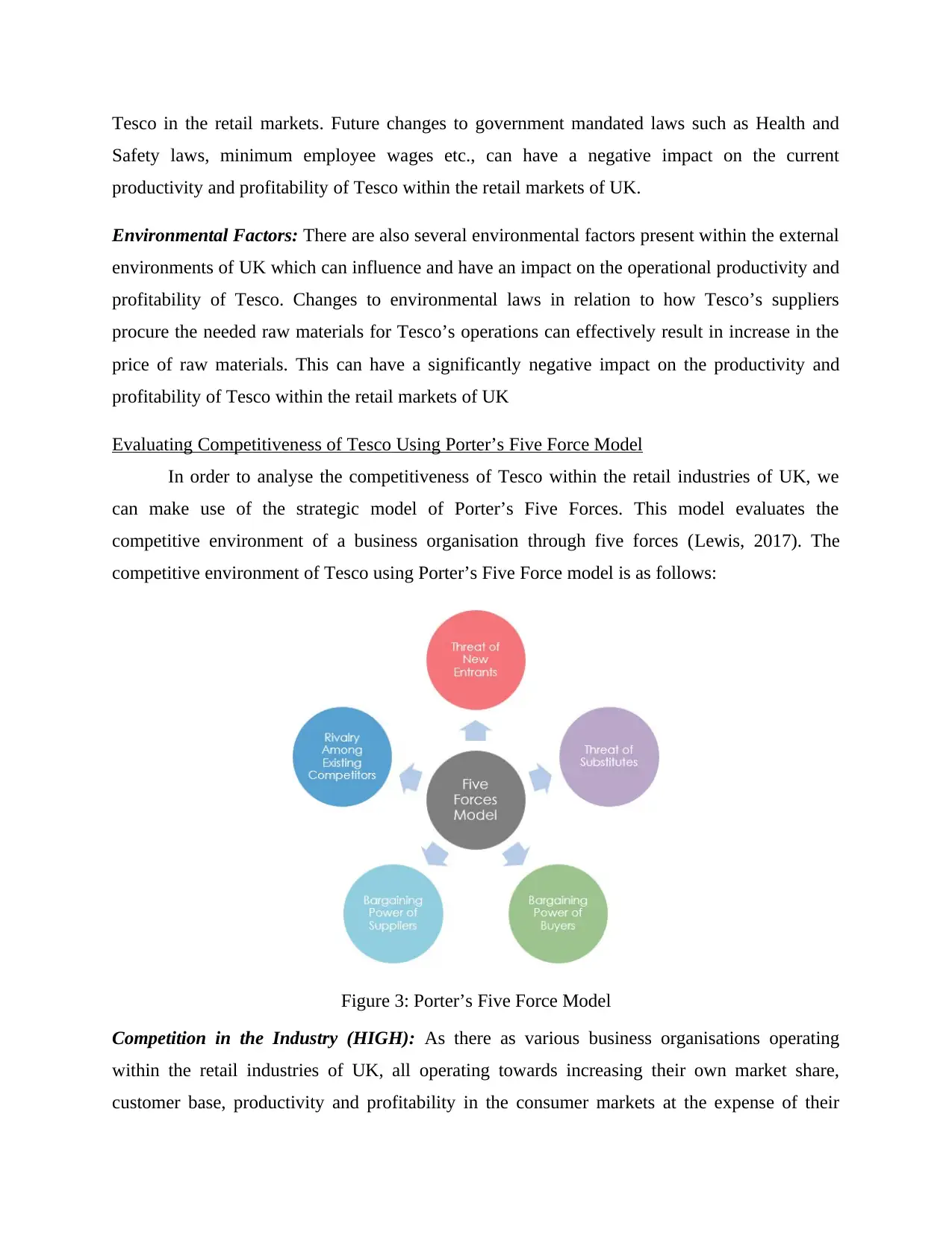
Tesco in the retail markets. Future changes to government mandated laws such as Health and
Safety laws, minimum employee wages etc., can have a negative impact on the current
productivity and profitability of Tesco within the retail markets of UK.
Environmental Factors: There are also several environmental factors present within the external
environments of UK which can influence and have an impact on the operational productivity and
profitability of Tesco. Changes to environmental laws in relation to how Tesco’s suppliers
procure the needed raw materials for Tesco’s operations can effectively result in increase in the
price of raw materials. This can have a significantly negative impact on the productivity and
profitability of Tesco within the retail markets of UK
Evaluating Competitiveness of Tesco Using Porter’s Five Force Model
In order to analyse the competitiveness of Tesco within the retail industries of UK, we
can make use of the strategic model of Porter’s Five Forces. This model evaluates the
competitive environment of a business organisation through five forces (Lewis, 2017). The
competitive environment of Tesco using Porter’s Five Force model is as follows:
Figure 3: Porter’s Five Force Model
Competition in the Industry (HIGH): As there as various business organisations operating
within the retail industries of UK, all operating towards increasing their own market share,
customer base, productivity and profitability in the consumer markets at the expense of their
Safety laws, minimum employee wages etc., can have a negative impact on the current
productivity and profitability of Tesco within the retail markets of UK.
Environmental Factors: There are also several environmental factors present within the external
environments of UK which can influence and have an impact on the operational productivity and
profitability of Tesco. Changes to environmental laws in relation to how Tesco’s suppliers
procure the needed raw materials for Tesco’s operations can effectively result in increase in the
price of raw materials. This can have a significantly negative impact on the productivity and
profitability of Tesco within the retail markets of UK
Evaluating Competitiveness of Tesco Using Porter’s Five Force Model
In order to analyse the competitiveness of Tesco within the retail industries of UK, we
can make use of the strategic model of Porter’s Five Forces. This model evaluates the
competitive environment of a business organisation through five forces (Lewis, 2017). The
competitive environment of Tesco using Porter’s Five Force model is as follows:
Figure 3: Porter’s Five Force Model
Competition in the Industry (HIGH): As there as various business organisations operating
within the retail industries of UK, all operating towards increasing their own market share,
customer base, productivity and profitability in the consumer markets at the expense of their
⊘ This is a preview!⊘
Do you want full access?
Subscribe today to unlock all pages.

Trusted by 1+ million students worldwide
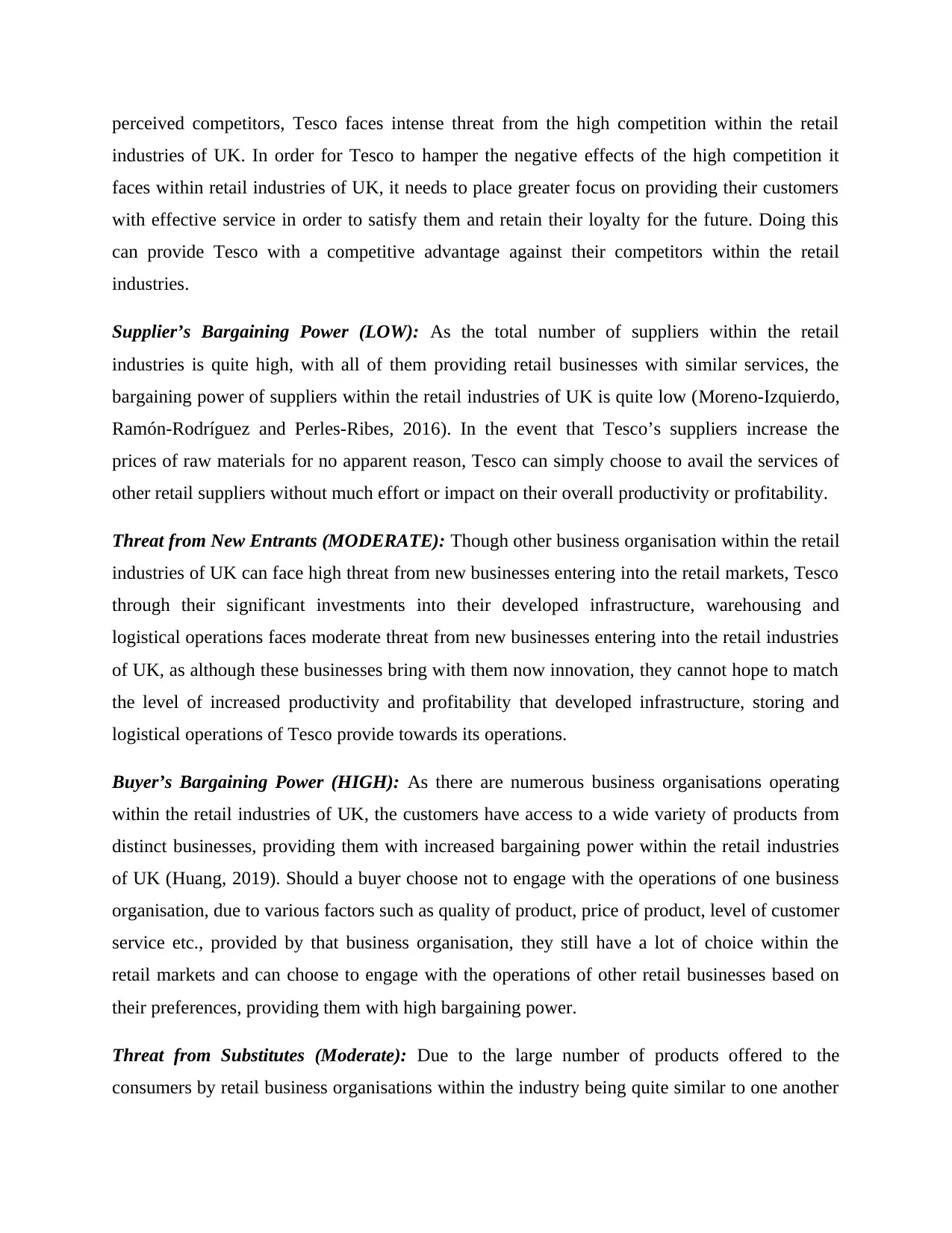
perceived competitors, Tesco faces intense threat from the high competition within the retail
industries of UK. In order for Tesco to hamper the negative effects of the high competition it
faces within retail industries of UK, it needs to place greater focus on providing their customers
with effective service in order to satisfy them and retain their loyalty for the future. Doing this
can provide Tesco with a competitive advantage against their competitors within the retail
industries.
Supplier’s Bargaining Power (LOW): As the total number of suppliers within the retail
industries is quite high, with all of them providing retail businesses with similar services, the
bargaining power of suppliers within the retail industries of UK is quite low (Moreno-Izquierdo,
Ramón-Rodríguez and Perles-Ribes, 2016). In the event that Tesco’s suppliers increase the
prices of raw materials for no apparent reason, Tesco can simply choose to avail the services of
other retail suppliers without much effort or impact on their overall productivity or profitability.
Threat from New Entrants (MODERATE): Though other business organisation within the retail
industries of UK can face high threat from new businesses entering into the retail markets, Tesco
through their significant investments into their developed infrastructure, warehousing and
logistical operations faces moderate threat from new businesses entering into the retail industries
of UK, as although these businesses bring with them now innovation, they cannot hope to match
the level of increased productivity and profitability that developed infrastructure, storing and
logistical operations of Tesco provide towards its operations.
Buyer’s Bargaining Power (HIGH): As there are numerous business organisations operating
within the retail industries of UK, the customers have access to a wide variety of products from
distinct businesses, providing them with increased bargaining power within the retail industries
of UK (Huang, 2019). Should a buyer choose not to engage with the operations of one business
organisation, due to various factors such as quality of product, price of product, level of customer
service etc., provided by that business organisation, they still have a lot of choice within the
retail markets and can choose to engage with the operations of other retail businesses based on
their preferences, providing them with high bargaining power.
Threat from Substitutes (Moderate): Due to the large number of products offered to the
consumers by retail business organisations within the industry being quite similar to one another
industries of UK. In order for Tesco to hamper the negative effects of the high competition it
faces within retail industries of UK, it needs to place greater focus on providing their customers
with effective service in order to satisfy them and retain their loyalty for the future. Doing this
can provide Tesco with a competitive advantage against their competitors within the retail
industries.
Supplier’s Bargaining Power (LOW): As the total number of suppliers within the retail
industries is quite high, with all of them providing retail businesses with similar services, the
bargaining power of suppliers within the retail industries of UK is quite low (Moreno-Izquierdo,
Ramón-Rodríguez and Perles-Ribes, 2016). In the event that Tesco’s suppliers increase the
prices of raw materials for no apparent reason, Tesco can simply choose to avail the services of
other retail suppliers without much effort or impact on their overall productivity or profitability.
Threat from New Entrants (MODERATE): Though other business organisation within the retail
industries of UK can face high threat from new businesses entering into the retail markets, Tesco
through their significant investments into their developed infrastructure, warehousing and
logistical operations faces moderate threat from new businesses entering into the retail industries
of UK, as although these businesses bring with them now innovation, they cannot hope to match
the level of increased productivity and profitability that developed infrastructure, storing and
logistical operations of Tesco provide towards its operations.
Buyer’s Bargaining Power (HIGH): As there are numerous business organisations operating
within the retail industries of UK, the customers have access to a wide variety of products from
distinct businesses, providing them with increased bargaining power within the retail industries
of UK (Huang, 2019). Should a buyer choose not to engage with the operations of one business
organisation, due to various factors such as quality of product, price of product, level of customer
service etc., provided by that business organisation, they still have a lot of choice within the
retail markets and can choose to engage with the operations of other retail businesses based on
their preferences, providing them with high bargaining power.
Threat from Substitutes (Moderate): Due to the large number of products offered to the
consumers by retail business organisations within the industry being quite similar to one another
Paraphrase This Document
Need a fresh take? Get an instant paraphrase of this document with our AI Paraphraser

and can easily be substituted for by the products offered by their competitors, most businesses
within the retail industries of UK face high threat from substitutes. Tesco faces moderate threat
from substitute products due to its investments into its own research and development
department, which allow for it to create innovative products, which cannot be substituted by its
competitors within the retail markets of UK. Contrastingly, Tesco also offers to its consumers its
products, which can be alternated and substituted for by the products offered by its competitors
within the retail industries.
Review of Tesco’s Business Strategy
This report judges the business strategy created and implemented by the leadership and
management of Tesco to be quite effective as it clearly lays out the mission, vision, purpose and
objectives that Tesco business organisation needs to achieve currently in the retail markets as
well as in the future. Due to this there is no confusion in the various distinct operational
processes of Tesco with regards to their own objectives and goals and how these contribute
towards the growth and development of Tesco towards achieving its end vision and missions.
The business strategy is also adequate, as it provides Tesco with a competitive advantage within
the retail industries against its competitors allowing for it to operate with increased performance,
efficiency and generate increased productivity, profitability, customer base and market share
within the retail markets of UK, on the basis of its valuable, rare, organised and some inimitable
internal components (Yuliansyah, Y., Gurd and Mohamed, 2017). The business strategy takes
into account all the factors which are present in the external environment in which Tesco
operates in, with the intention to avail opportunities these factors present and be wary of the
threats present in the external environment within retail markets of UK. The business strategy of
Tesco also factors in the competitive environment of the retail industries in order to assess how
they can further gain a sustained competitive advantage within the retail industries of UK,
allowing for increased productivity and profitability for the retail business.
Though all the business strategy of Tesco is quite effective and adequate towards
achieving its end goals, objectives and vision, there are still some recommendations which if
implemented into the business strategy of Tesco can help the business organisation achieve its
objectives and vision in a faster and efficient manner, while also providing it with a competitive
advantage against their competitors within the retail industries of UK (Sia, Soh and Weill, 2016).
within the retail industries of UK face high threat from substitutes. Tesco faces moderate threat
from substitute products due to its investments into its own research and development
department, which allow for it to create innovative products, which cannot be substituted by its
competitors within the retail markets of UK. Contrastingly, Tesco also offers to its consumers its
products, which can be alternated and substituted for by the products offered by its competitors
within the retail industries.
Review of Tesco’s Business Strategy
This report judges the business strategy created and implemented by the leadership and
management of Tesco to be quite effective as it clearly lays out the mission, vision, purpose and
objectives that Tesco business organisation needs to achieve currently in the retail markets as
well as in the future. Due to this there is no confusion in the various distinct operational
processes of Tesco with regards to their own objectives and goals and how these contribute
towards the growth and development of Tesco towards achieving its end vision and missions.
The business strategy is also adequate, as it provides Tesco with a competitive advantage within
the retail industries against its competitors allowing for it to operate with increased performance,
efficiency and generate increased productivity, profitability, customer base and market share
within the retail markets of UK, on the basis of its valuable, rare, organised and some inimitable
internal components (Yuliansyah, Y., Gurd and Mohamed, 2017). The business strategy takes
into account all the factors which are present in the external environment in which Tesco
operates in, with the intention to avail opportunities these factors present and be wary of the
threats present in the external environment within retail markets of UK. The business strategy of
Tesco also factors in the competitive environment of the retail industries in order to assess how
they can further gain a sustained competitive advantage within the retail industries of UK,
allowing for increased productivity and profitability for the retail business.
Though all the business strategy of Tesco is quite effective and adequate towards
achieving its end goals, objectives and vision, there are still some recommendations which if
implemented into the business strategy of Tesco can help the business organisation achieve its
objectives and vision in a faster and efficient manner, while also providing it with a competitive
advantage against their competitors within the retail industries of UK (Sia, Soh and Weill, 2016).

The business strategy of Tesco needs to emphasise and place focus on making use of the
principle of economies of scale in order to make use of its large scale operations to manufacture
products at large scales, which would effectively help the retail business decrease the consumer
price of individual products, allowing for increased customer base, market share, productivity
and profitability to be sustained by Tesco, while also providing it with a competitive edge against
its numerous competitors within the retail industries, who cannot decrease their own product
prices to the levels that Tesco can using this approach as part of their business strategy.
CONCLUSION
Based on the findings of the report, it can be concluded that Tesco possesses effective
business strategy that allows it operate with increased performance, efficiency, productivity and
profitability in the consumer markets, while also providing it with a competitive advantage
against its perceived competitors within the retail industries. This report examines the value of
vision, purpose, mission and objectives of Tesco’s business strategy. In order to assess the
competitive advantage possessed by Tesco, the report makes use of VRIO framework. The report
also evaluates the external environment of Tesco by applying PESTLE analysis. To analyse the
competitive environment in which Tesco operates in, the report uses Porter’s Five Force model.
Finally, the report reviews Tesco’s business strategy.
principle of economies of scale in order to make use of its large scale operations to manufacture
products at large scales, which would effectively help the retail business decrease the consumer
price of individual products, allowing for increased customer base, market share, productivity
and profitability to be sustained by Tesco, while also providing it with a competitive edge against
its numerous competitors within the retail industries, who cannot decrease their own product
prices to the levels that Tesco can using this approach as part of their business strategy.
CONCLUSION
Based on the findings of the report, it can be concluded that Tesco possesses effective
business strategy that allows it operate with increased performance, efficiency, productivity and
profitability in the consumer markets, while also providing it with a competitive advantage
against its perceived competitors within the retail industries. This report examines the value of
vision, purpose, mission and objectives of Tesco’s business strategy. In order to assess the
competitive advantage possessed by Tesco, the report makes use of VRIO framework. The report
also evaluates the external environment of Tesco by applying PESTLE analysis. To analyse the
competitive environment in which Tesco operates in, the report uses Porter’s Five Force model.
Finally, the report reviews Tesco’s business strategy.
⊘ This is a preview!⊘
Do you want full access?
Subscribe today to unlock all pages.

Trusted by 1+ million students worldwide
1 out of 13
Related Documents
Your All-in-One AI-Powered Toolkit for Academic Success.
+13062052269
info@desklib.com
Available 24*7 on WhatsApp / Email
![[object Object]](/_next/static/media/star-bottom.7253800d.svg)
Unlock your academic potential
Copyright © 2020–2025 A2Z Services. All Rights Reserved. Developed and managed by ZUCOL.





